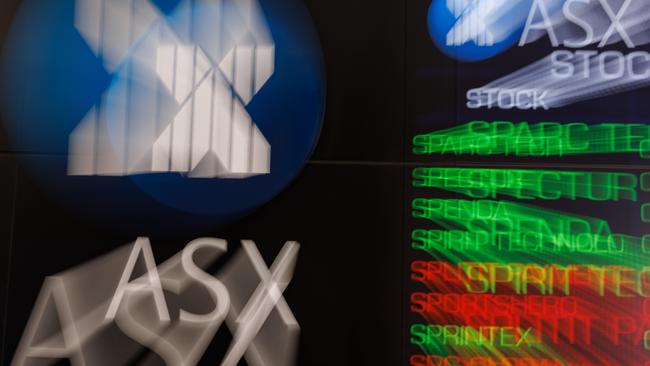Jim Chalmers’ Treasury in bold attempt to map out the cryptoverse
The collapse of global exchange FTX is pushing regulators into new territory as they attempt to get a handle on crypto.

Business
Don't miss out on the headlines from Business. Followed categories will be added to My News.
Jim Chalmers’ Treasury is attempting to go where few have gone before: mapping out the known reaches of the cryptoverse.
There’s good reason for doing so. Crypto-based assets such as Bitcoin and Ethereum, and the rising number of trading exchanges, are becoming an even bigger part of the economy but remain a major blind spot for authorities.
Treasury now estimates that over a million Australians are likely to include crypto assets on last year’s tax returns and there is little or no regulation around the asset class. By their nature, for every crypto asset declared there is likely to be another that is held in the shadows.
Treasury has quietly issued a consultation paper covering token mapping, starting out the ambitious task of looking at all the activity and assets in the crypto world to match them against the existing regulations. The consultation will also consider what additional regulations are needed.
The landmark paper has been released in the shadow of the collapse of FTX, the giant trading platform that is increasingly looking like a global Ponzi scheme. FTX’s baby-faced founder Sam Bankman-Fried also sucked in tens of thousands of unwitting Australians, with fears that much of their funds may have simply vanished into the cryptosphere.
FTX’s multibillion-dollar unravelling added to the urgency in getting regulation in place so investors can at least have some confidence their funds are backed by more than a promise when they play in the crypto market.

Liberal senator Andew Bragg got the ball rolling on crypto regulation through a Senate report released by the Morrison government calling for a framework around digital assets including bitcoin and non-fungible tokens (NFT) better known for their links to artwork. The aim, which included a push for tougher regulation around exchanges, was designed to build retail investor confidence and grow the sector.
As well as consumer protection, Treasury has another reason for wanting to map out the crypto space. It is worried about financial stability risks to the economy from the volatility in assets like bitcoin or a repeat of more FTX-style collapses.
This volatility, combined with the increased exposure of Australian business and consumers to the performance of crypto assets, raises the risk that losses could eventually feed through to impact the broader economy, the Treasury paper says.
Crypto isn’t entirely regulation-free. Indeed Treasury already regards financial watchdogs ASIC, ACCC, Austrac and the ATO as already providing policing clout of digital assets through existing rules around consumer protection, financial advice and money laundering.
But the technical and economic complexity, open and permissionless nature, and breadth of possible applications of crypto networks is likely to expose major shortfalls in existing regulation.
“This is particularly important where the crypto ecosystem intersects with the financial system,” Treasury cautions.
Ruling the ‘Wild West’
Using the feedback from token mapping consultation, the Albanese government plans to release a consultation paper around the middle of this year outlining rules around the licensing and custody framework for crypto exchanges. This will be the first big step to rein in the idea of the digital Wild West that exchanges like FTX have helped advance.
Crypto has indeed come a long way with the Reserve Bank also investigating if there’s an argument to use a central bank digital currency in Australia. It has brought in the Digital Finance Cooperative Research Centre to help with the project, which includes piloting a digital currency. The idea here is the currency will be able to speed up big transactions for banks, including foreign exchange trading and offshore payments. Elsewhere, until late last year the ASX was using the code behind bitcoin – blockchain – to replace its share settlement system.
Treasury takes the view that crypto is only going to get bigger, despite relative immature nature of the assets, including the collapse in value last year. Bitcoin, the most widely traded crypto currency, crashed more than 60 per cent last year, however it has been off to a stronger start in January, surging 40 per cent. Even so, these massive swings highlight the volatility of crypto, which has been likened by some as trading in digital nitroglycerine. Australia is already home to a “thriving community” of crypto ecosystem businesses, Treasury says, including network infrastructure providers, code auditors, trading platforms, online gaming companies, and software engineers. If the crypto ecosystem matures and develops, it could open significant new opportunities for businesses. Crypto can potentially create jobs and foster new technology, the Treasury paper says, adding an overriding principle of crypto’s development is that it needs to be technology neutral. But first it needs to know what it dealing with.
Heat warning
Aaron Binsted, one of the few fund managers to defy last year’s market meltdown, has cautioned there are overheated stocks that haven’t caught up with the realities of fast-paced interest rate hikes.
Heading into the February profit reporting season, Binsted – a portfolio manager at Lazard Asset Management – says corporate Australia is yet to see the full hit to earnings from the last year’s aggressive round of cash rate hikes. Part of this is largely due to hundreds of billions of fixed rate mortgages written through the Covid period are still yet to reprice at the higher rate. This so-called fixed mortgage rate cliff, along with a sharp slowdown in the economy, rising unemployment and falling house prices, is yet to be felt at the profit line.
Binsted’s comments come as the Australian sharemarket is sitting just 0.9 per cent below its highest. This is all the more remarkable given the Reserve Bank is not done with its hikes yet. On Tuesday the central bank is widely expected to push through another 25 basis point hike.
Binsted’s Lazard Select Australian Equity fund last year delivered returns of 11.7 per cent, making it the top performing Australian shares fund for calendar 2022, according to figures compiled by Mercer.

The double-digit returns for Lazard came in a year when just a handful of Australian share funds finished in positive territory, with the average coming in at negative 5.5 per cent. At the same time the benchmark S&P/ASX 300 index returned negative 8 per cent for the year.
For Australia, services and wage inflation are still grinding pressures on the economy. The recent higher-than-expected inflation number confirmed this, Binsted says.
“We were very behind in terms of getting inflation and then having monetary policy response in Australia and so maybe we’re going to lag on the cost side, too. This means the economic impacts from the interest rate increases are being delayed,” he says in an interview.
Binsted says the returns on his value-style fund last year came about largely by avoiding being in speculative, low-quality stocks in the first place. This includes loss-making tech names best characterised by the buy now, pay later bubble.
“As interest rates went up the souffle deflated. And we weren’t in those stocks and were spared that big detraction from our portfolio.”

Instead, he stuck to his long-held rule of backing established names with high cash flows. Cash was given little value by most investors in a market of near-zero interest rates compared to the weight of money chasing growth. Here share registry group Computershare and supermarket operators Coles and Metcash were strong performers for Binsted. Also energy stocks made a big contribution and this has continued to boost his portfolio into this year.
“We’re not trying to look at what’s a hot stock or a hot sector or what’s going to have upgrades next year, it’s really about what is the long-term sustainable cash flow and can we buy at an attractive price? That’s really what we spend our time doing,” he says.
Heading into profit season Binsted says there’s still significant “mis-pricing” across different parts of the Australian market, particularly around tech. At the peak of 2021 the pricing of some shares was more overheated than the tech bubble of 2000. And Binsted believes on some measures it has only “half corrected”, and is still likely to unravel over next two to three years.
“That means if you’re on the right side of that we think that’s a really attractive opportunity. So there’s still a lot of mis-pricing out there to take advantage of.”
Australia, too, still has some way to go in its inflation battle, even with signs it may have peaked in other parts of the world, and this is adding to risks around corporate earnings. Even with the US Federal Reserve still cautioning of more interest rate hikes to come after last week’s 25 basis point rise, markets are still pricing in rate cuts there by the end of this year or into early 2024, thinking which has underpinned the latest global share rally. Australia will eventually follow the US with lower rates but Binsted says it’s important to remind yourself why.
“If they’re cutting it’s because the economy is bad, and earnings are tough. You just need to be a bit patient and wait for that to play out before getting too excited”.
johnstone@theaustralian.com.au
Originally published as Jim Chalmers’ Treasury in bold attempt to map out the cryptoverse



